
Equipment
Truck Tech: November 2012
Now for something different: all-terrain vehicles (ATVs) in the fire service.
November 1, 2012
By Chris Dennis
Now for something different: all-terrain vehicles (ATVs) in the fire service.
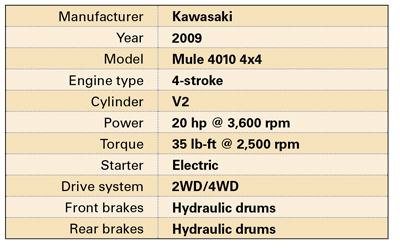
|
|
Recently, I became the proud owner of a new ATV. As a kid, I was involved with all things motorized, and I have had a few ATVs – including some that were meant to be on water and some that go off-road. I have always had a passion for things that go places where people were not intended to go, and I know I am not the only person who feels this way. Recreational vehicles have become as common as mp3 players and cellphones, and can be seen driving up and down the road or being hauled on trailers. These machines are also becoming common in our fire stations. Along with big red rigs are boats, planes, helicopters, snowmobiles and whatever else we can muster up to make the job safer and more productive.
Across the country, Canadians will forever venture out to do things outdoors that make them happy. Unfortunately, at times, things go wrong. When we are called to duty, no matter what the incident, we can be sure the individual or individuals involved did not plan to get into that situation.
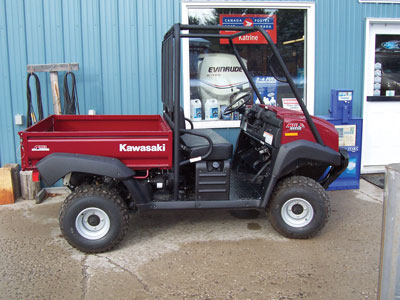 |
|
| Vaughan Fire & Rescue Services’ Kawasaki Mule, before it was outfitted to suit the department’s needs. Photo courtesy of Katrine Marine |
|
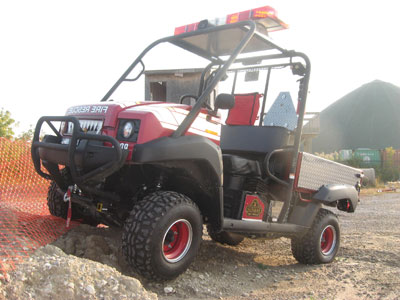 |
|
| The Kawasaki Mule after adding emergency lights, aluminum plate, and Vaughan Fire & Rescue Services decals. Photo by Chris Dennis |
|
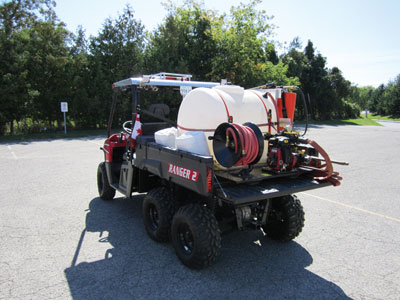 |
|
| This Ranger 2 ATV, which belongs to the Adjala-Tosorontio Fire Department in Ontario, is outfitted with a water tank and hose. Photo by Chris Dennis | |
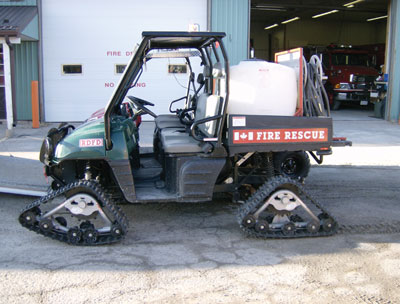 |
|
| Another of Adjala-Tosorontio’s ATVs features track wheels to use during the winter, and a water tank and hose. Photo by Chris Dennis |
|
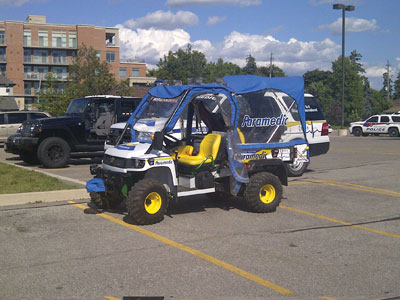 |
|
| The York Region EMS 2009 John Deere Gator has been outfitted to support the service’s needs. Photo by Chris Dennis | |
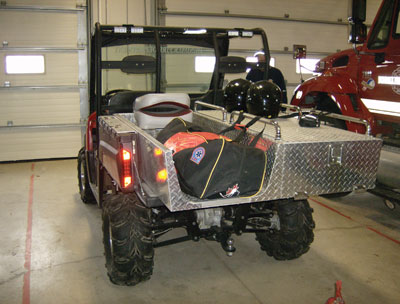 |
|
| This Adjala-Tosorontio Fire Department rescue ATV has space to store equipment and to transport a patient. Photo by Chris Dennis Advertisement
|
The following is a typical example. One November, a gentleman takes a walk into the forest after dinner. A couple of hours later, he still has not come back. The fire communication centre answers the phone, “911; what is your emergency?” The caller says, “My father has gone for a walk into the bush as he has done before to relax after dinner and has not come back. He has never been gone this long before and it’s getting dark and cold outside. I am worried.” The 911 dispatcher goes into action and asks the questions he or she has been trained to ask in such an emergency. The dispatcher assures the caller all will be fine, that fire, police and EMS are on their way and that the caller should stay by the phone in case of a call. The tones go off in the fire hall and the firefighters move into action, listening for the message over the radio. “Rescue 729, Technical Rescue 759, Chief 74, Utility 720, ATV 1: Respond to 123 ABC Side Road for person possibly lost in the forest.”
As emergency responders, you know that the adrenalin meter moves up a bit and you do what you where trained to do. All units arrive on scene within a few minutes of receiving the call. At this time, a command centre is developed and a plan is devised. It is dark now, at 2000 hours. This person has now been in the elements for more than two hours. The bush is thick and dark. Behind Utility 720 is a trailer, and on that trailer is the four-wheel-drive ATV 1. The ATV and crew head into the dense bush. With trailer in tow and full radio communication, a call comes from incident command (IC) to ATV 1. Police have a helicopter in the area and have reported nothing found at this time.
About 10 minutes into the forest with the crew of ATV 1, the radio opens with a report: “ATV 1 to command.” ATV 1 has come across a large hill. It is too dark to tell how steep.
“We are setting up our remote generator and overhead lighting,” ATV 1 says. “We can see the helicopter searchlight overhead.”
With GPS in hand, they give IC their co-ordinates.
“Command, we see what appears to be a heat image on our thermal imaging camera. We have made visual contact with our scene lights to a person waving us down the hill.
The person from here appears to be in distress and is not vocally answering our calls to him. We are disconnecting the trailer and moving down the hill in ATV 1. Stand by.
“We have made patient contact. The patient is tired, cold and tells us he is hungry again. Request second ATV team to come to our location to help with extrication of the patient.”
So, all is good. The father sustained minor injuries and goes home from hospital a couple of days later, proving once again that, when the fire department involved is well trained, with great tools at its disposal, a safe and happy ending is possible for everybody.
To help make ATVs even more effective for rescuers, Kawasaki also offers a lot of add-ons. The best features are the engine size – 617-cc, V-twin engine, liquid-cooled; and the 60-litre, sealed storage compartment in the dash, featuring dual-sealed glove boxes and cup holders on both sides of the cabin. The steel dump box and seating configuration work well for fire-department purposes. The lighting and siren system are all Whelen and provide great illumination when responding or when used at public education events.
Over the years, at both FDIC and the trade show at the Ontario Association of Fire Chiefs conference, manufacturers have introduced more of these off-road units; just run emergency ATV through Google and see what comes up. Police, EMS and the fire service are finding a need for this type of vehicle. The options from the ATV builders are widening. At one time, you were restricted to a few manufacturers that made accessories for these vehicles. The manufacturers now have complete slide-in fire pump packages, as well as medical units and trailers.
So, as you can see, and I have said it before, we are an inventive lot. From tracks to tires, from four-wheel-drive to six-wheel-drive, the ATV has found a place in the emergency services. My December column will discuss care and maintenance of these multi-purpose vehicles.
Thanks to Fire Chief Wayne McIsaac of the Adjala-Tosorontio Fire Department in Ontario for showing me his ATVs and letting me photograph them.
Remember, my friends, rubber side down.
Chris Dennis is the chief mechanical officer for Vaughan Fire & Rescue Services in Ontario. E-mail him at Chris.Dennis@vaughan.ca
Print this page